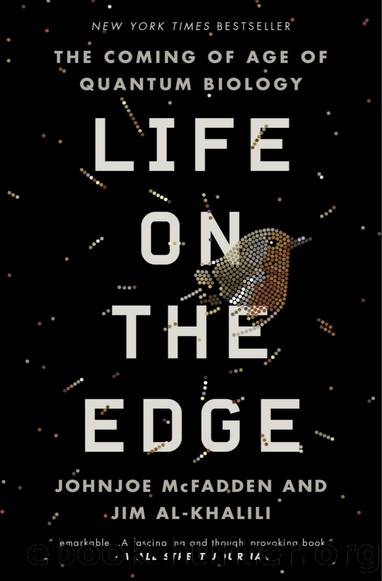Life on the Edge: The Coming of Age of Quantum Biology by Jim Al-Khalili

Author:Jim Al-Khalili [Al-Khalili, Jim]
Language: eng
Format: epub
ISBN: 9780307986825
Google: gyaJDAAAQBAJ
Barnesnoble:
Publisher: Crown
Published: 2015-07-28T00:00:00+00:00
Figure 6.1: The earthâs magnetic field lines and the angle of inclination.
In their 1972 experiments the Wiltschkos trapped the test birds in a shielded chamber and subjected them to an artificial magnetic field. Crucially, reversing the polarity of the field, by turning the magnet around by 180°, had no effect on their behavior: the birds would orientate themselves in relation to the closest magnetic pole, whichever one it happened to be; so they didnât possess a conventional magnetic compass. That 1972 paper established that the robinsâ magnetoreceptor was indeed an inclination compass. But how it worked remained a mystery.
Then in 1974 Wolfgang and Roswitha were invited to Cornell University in the United States by the American bird migration expert Steve Emlen. In the 1960s he had developed with his father, John, also a highly respected ornithologist, a special bird chamber that became known as an Emlen funnel.*1 Shaped like an inverted cone, this funnel has an ink pad at the bottom and blotting paper on the interior sloping sides (figure 6.2). When a bird hops or flutters up the sloping walls it leaves telltale footprints that give information about the preferred direction in which it would fly if it could escape. The bird species the Wiltschkos studied at Cornell University was the indigo bunting, a small North American songbird that, like the European robin, migrates using some kind of internal compass. Their year-long study of this birdâs behavior inside the Emlen funnel was published in 1976,12 and established beyond doubt that the indigo bunting, like the robin, was able to detect the geomagnetic field. Wolfgang Wiltschko regards the publication of this first Cornell-based paper as the teamâs breakthrough moment, for it established beyond doubt that migratory birds have a built-in magnetic compass and caught the attention of many of the worldâs leading ornithologists.
Of course, no one in the mid-1970s had a clue how a biological magnetic compass might work. However, as we saw in chapter 1, in the same year that the Wiltschkos and Stephen Emlen published their work, the German chemist Klaus Schulten proposed a chemical mechanism that links light with magnetoreception. Schulten had recently graduated from Harvard with a PhD in chemical physics and returned to Europe, where he obtained a position at the Max Planck Institute for Biophysical Chemistry in Göttingen. There he became interested in the possibility that electrons generated in the fast triplet reaction by exposure to light could be quantum entangled. His calculations suggested that if entanglement was indeed involved in chemical reactions then the speed of these reactions should be affected by an external magnetic field, and he proposed a way of proving his theory.
Download
This site does not store any files on its server. We only index and link to content provided by other sites. Please contact the content providers to delete copyright contents if any and email us, we'll remove relevant links or contents immediately.
| Anatomy | Animals |
| Bacteriology | Biochemistry |
| Bioelectricity | Bioinformatics |
| Biology | Biophysics |
| Biotechnology | Botany |
| Ecology | Genetics |
| Paleontology | Plants |
| Taxonomic Classification | Zoology |
Sapiens: A Brief History of Humankind by Yuval Noah Harari(13073)
The Tidewater Tales by John Barth(12038)
Do No Harm Stories of Life, Death and Brain Surgery by Henry Marsh(6342)
Mastermind: How to Think Like Sherlock Holmes by Maria Konnikova(6250)
The Thirst by Nesbo Jo(5792)
Why We Sleep: Unlocking the Power of Sleep and Dreams by Matthew Walker(5655)
Sapiens by Yuval Noah Harari(4551)
Life 3.0: Being Human in the Age of Artificial Intelligence by Tegmark Max(4519)
The Longevity Diet by Valter Longo(4451)
The Rules Do Not Apply by Ariel Levy(3913)
The Immortal Life of Henrietta Lacks by Rebecca Skloot(3833)
The Body: A Guide for Occupants by Bill Bryson(3815)
Why We Sleep by Matthew Walker(3779)
Animal Frequency by Melissa Alvarez(3760)
Yoga Anatomy by Kaminoff Leslie(3710)
Barron's AP Biology by Goldberg M.S. Deborah T(3636)
The Hacking of the American Mind by Robert H. Lustig(3587)
All Creatures Great and Small by James Herriot(3526)
Yoga Anatomy by Leslie Kaminoff & Amy Matthews(3404)
